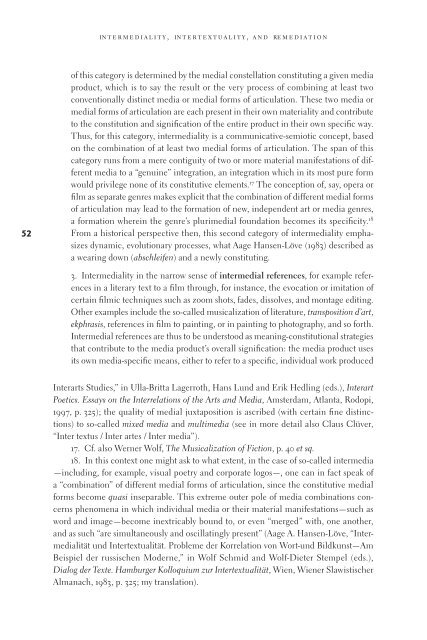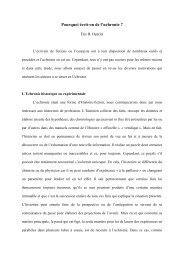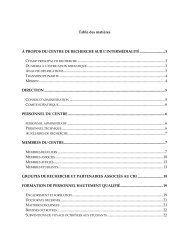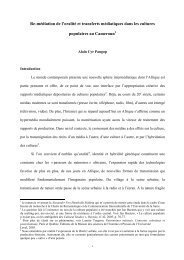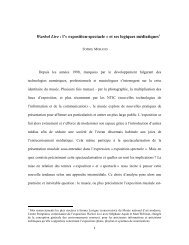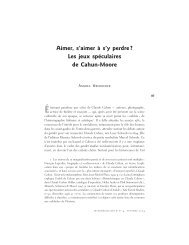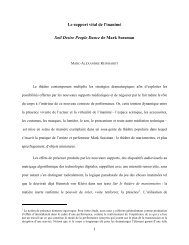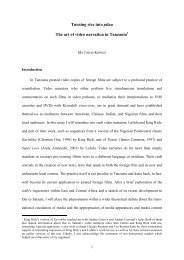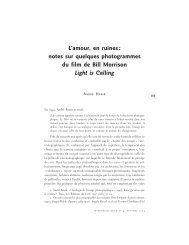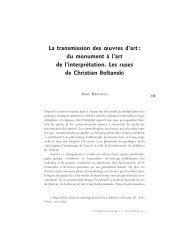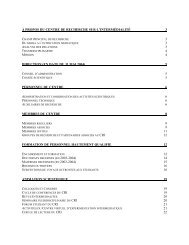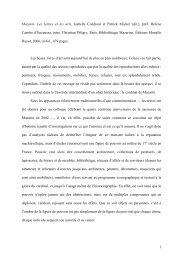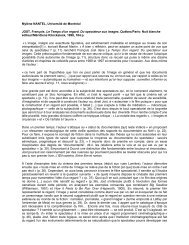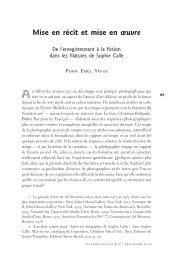Intermediality - Centre de recherche sur l'intermédialité (CRI ...
Intermediality - Centre de recherche sur l'intermédialité (CRI ...
Intermediality - Centre de recherche sur l'intermédialité (CRI ...
Create successful ePaper yourself
Turn your PDF publications into a flip-book with our unique Google optimized e-Paper software.
52<br />
intermediality, intertextuality, and remediation<br />
of this category is <strong>de</strong>termined by the medial constellation constituting a given media<br />
product, which is to say the result or the very process of combining at least two<br />
conventionally distinct media or medial forms of articulation. These two media or<br />
medial forms of articulation are each present in their own materiality and contribute<br />
to the constitution and signifi cation of the entire product in their own specifi c way.<br />
Thus, for this category, intermediality is a communicative-semiotic concept, based<br />
on the combination of at least two medial forms of articulation. The span of this<br />
category runs from a mere contiguity of two or more material manifestations of different<br />
media to a “genuine” integration, an integration which in its most pure form<br />
would privilege none of its constitutive elements. 17 The conception of, say, opera or<br />
fi lm as separate genres makes explicit that the combination of different medial forms<br />
of articulation may lead to the formation of new, in<strong>de</strong>pen<strong>de</strong>nt art or media genres,<br />
a formation wherein the genre’s plurimedial foundation becomes its specifi city. 18<br />
From a historical perspective then, this second category of intermediality emphasizes<br />
dynamic, evolutionary processes, what Aage Hansen-Löve (1983) <strong>de</strong>scribed as<br />
a wearing down (abschleifen) and a newly constituting.<br />
3. <strong>Intermediality</strong> in the narrow sense of intermedial references, for example references<br />
in a literary text to a fi lm through, for instance, the evocation or imitation of<br />
certain fi lmic techniques such as zoom shots, fa<strong>de</strong>s, dissolves, and montage editing.<br />
Other examples inclu<strong>de</strong> the so-called musicalization of literature, transposition d’art,<br />
ekphrasis, references in fi lm to painting, or in painting to photography, and so forth.<br />
Intermedial references are thus to be un<strong>de</strong>rstood as meaning-constitutional strategies<br />
that contribute to the media product’s overall signifi cation: the media product uses<br />
its own media-specifi c means, either to refer to a specifi c, individual work produced<br />
Interarts Studies,” in Ulla-Britta Lagerroth, Hans Lund and Erik Hedling (eds.), Interart<br />
Poetics. Essays on the Interrelations of the Arts and Media, Amsterdam, Atlanta, Rodopi,<br />
1997, p. 325); the quality of medial juxtaposition is ascribed (with certain fi ne distinctions)<br />
to so-called mixed media and multimedia (see in more <strong>de</strong>tail also Claus Clüver,<br />
“Inter textus / Inter artes / Inter media”).<br />
17. Cf. also Werner Wolf, The Musicalization of Fiction, p. 40 et sq.<br />
18. In this context one might ask to what extent, in the case of so-called intermedia<br />
—including, for example, visual poetry and corporate logos—, one can in fact speak of<br />
a “combination” of different medial forms of articulation, since the constitutive medial<br />
forms become quasi inseparable. This extreme outer pole of media combinations concerns<br />
phenomena in which individual media or their material manifestations—such as<br />
word and image—become inextricably bound to, or even “merged” with, one another,<br />
and as such “are simultaneously and oscillatingly present” (Aage A. Hansen-Löve, “Intermedialität<br />
und Intertextualität. Probleme <strong>de</strong>r Korrelation von Wort-und Bildkunst—Am<br />
Beispiel <strong>de</strong>r russischen Mo<strong>de</strong>rne,” in Wolf Schmid and Wolf-Dieter Stempel (eds.),<br />
Dialog <strong>de</strong>r Texte. Hamburger Kolloquium zur Intertextualität, Wien, Wiener Slawistischer<br />
Almanach, 1983, p. 325; my translation).


